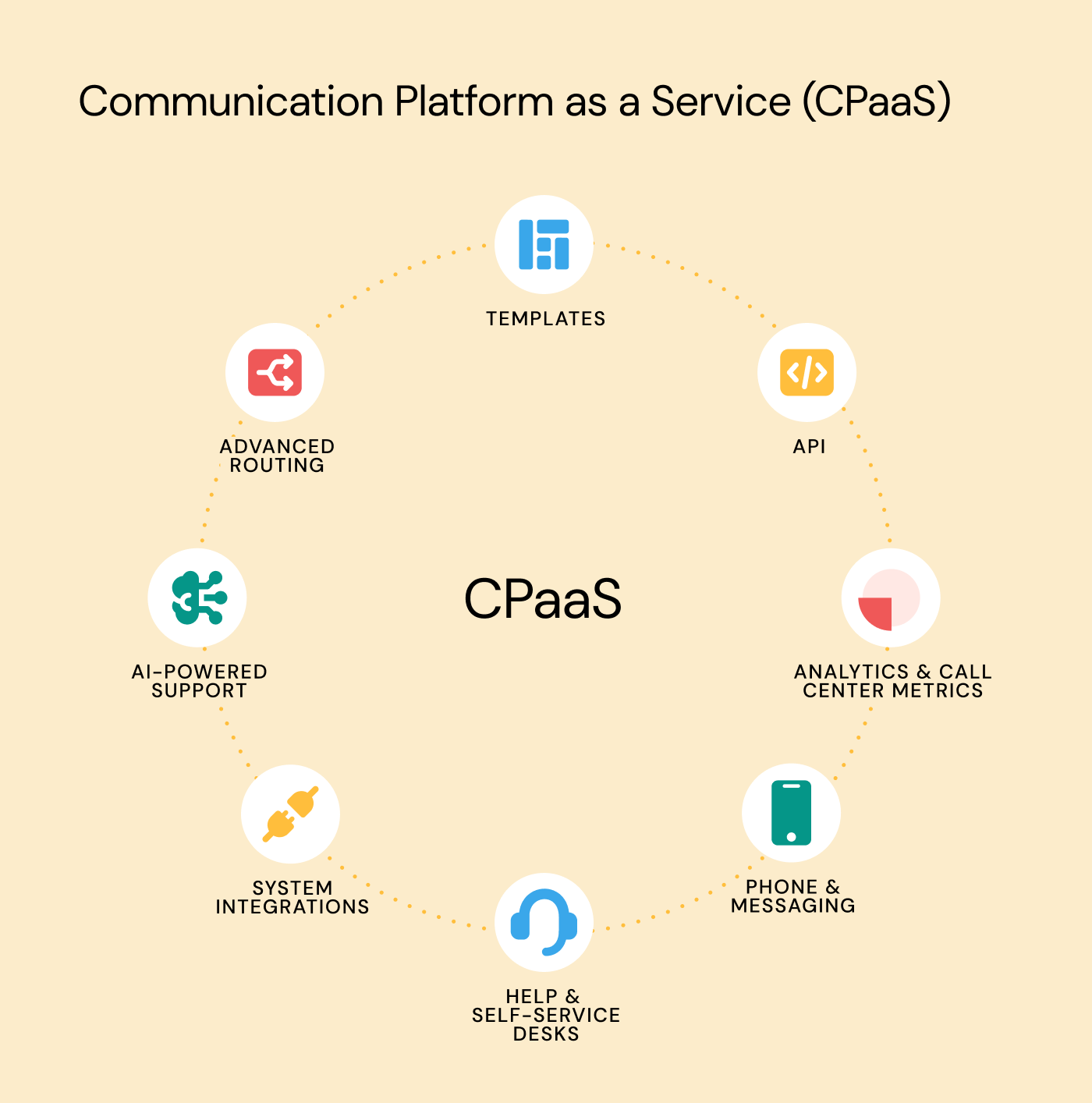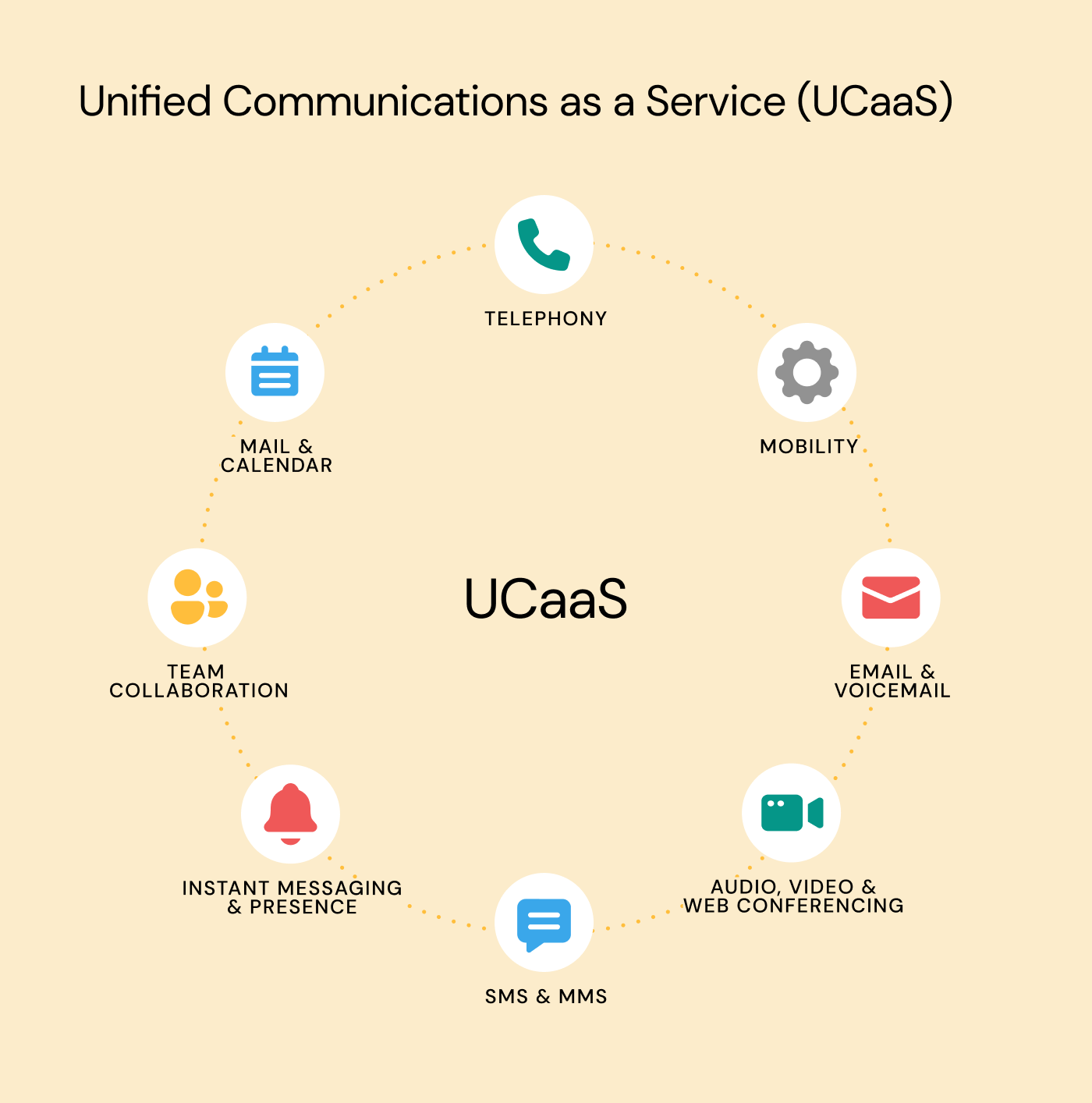Insights
CPaaS vs UCaaS: Unpacking the differences

Insights

Effective business communication solutions are crucial for customer experience and employee engagement across channels. But knowing which apps or services are right for you and your business can be tricky. Oftentimes, companies find themselves juggling multiple communication platforms to get the job done, which compounds the already challenging issue of integration.
That’s where CPaaS and UCaaS come in.
In this blog post, we break down these “as a service” powerhouse solutions to help you understand their differences, how they work, and which is the best fit for your operations.
Communications Platform as a Service, or CPaaS, is a cloud-based communication service that gives businesses the ability to easily upgrade their communication stack and strategies with an Application Programming Interface (API).
The API is what allows your existing software to “talk” to cloud apps. Put simply, you can add voice, video, email, or messaging services to your communications. And the key word here is “you”—since any CPaaS solution can be picked with services to best meet your needs and build the right solution for your business.
You can use CPaaS for outgoing calls, inbound call routing, web real-time communication (WebRTC) for adding video and voice to your websites and mobile apps, text messaging, social media messaging, and number masking for caller anonymity.
Moreover, CPaaS can bolster security with two-factor authentication and encryption to protect sensitive data. You can also tap into its conversational AI to automate customer interactions with chatbots.

There are a lot of reasons to choose CPaaS for businesses. Here are some of the more noticeable ones:
Imagine having the power to effortlessly adjust the size of your communication setup to fit your company’s evolving needs. CPaaS tools offer that. Whether you’re rapidly growing or need to scale down, it’s a breeze, without the headache of dealing with costly hardware and software.
Instead of draining your team with thousands of hours building your own communication platform, CPaaS allows you to seamlessly integrate communication features into your apps. This not only saves time and resources but also spares you from the ongoing maintenance hassles when doing it all in-house.
A top-notch CPaaS solution encrypts data during transit and at rest, has robust access controls, and shields data privacy. Plus, security audits and testing occur regularly.
Admins can layer on multiple security levels, tweak user access permissions, enforce ironclad password policies, and apply extra protection with two-factor authentication, depending on the use case.
UCaaS, short for Unified Communications as a Service, is a cloud-based-communication platform that bundles team messaging, video calls, phones, and collaboration tools into a single offering, sparing you the headache of managing multiple apps.
But UCaaS offers more than convenience. Since it’s cloud-based, it empowers you to communicate from almost anywhere with an internet connection. Plus, it eliminates the need for costly Voice over Internet Protocol (VoIP) hardware. Moving to the cloud also makes it easier to scale up and ensures better resilience in emergencies.
The best part? You don’t need to be a tech expert to use it. Most UCaaS providers handle the complex backend stuff, like security and setup, so you can focus on growing your business.
UCaaS doesn’t only make things easier, it’s also packed with features like:

Let’s explore some of the major benefits of a UCaaS solution.
When you switch to UCaaS, you’ll slash your implementation expenses. Say goodbye to costly server hardware. No more managing data centers, whether in-house or in the cloud. This move not only frees up valuable data center space but also ensures your users get a great experience.
It’s also a win-win situation when it comes to operational management. Since there’s no physical hardware to maintain or update, your IT operations become leaner and more efficient. It’s a straightforward way for businesses to reduce upfront costs while keeping their unified communications (UC) platform in tip-top shape.
In today’s world of hybrid and remote work, UCaaS is the perfect solution to empower your team to communicate from anywhere with just an internet connection. It’s the ideal system for companies embracing a work-from-anywhere policy, making it easier for employees to manage their workflows. That’s a huge upside since on-premises UC platforms come with delays and hefty costs when deployed across multiple locations.
CPaaS and UCaaS are both service-oriented, cloud-based communication solutions. And recently, advances in technology have made them more similar.
But there are a few key differences to keep in mind between them. Here’s a quick chart to reference as you choose between a UCaaS vs CPaaS solution.
|
|
UCaaS |
CPaaS |
|
What is it |
An all-in-one communication and collaboration package for businesses, using voice calls, video meetings, chat, and more |
A toolbox for developers to add communication functionalities into their apps |
|
What it’s for |
Businesses seeking a new set of contact center capabilities that focus on enhancing internal communication |
Businesses aiming to tailor and incorporate communication features into an existing application |
|
Features |
Chat, VoIP calls, video conferencing, email integration, mobile applications, fax, and more |
Conversational messaging, SMS, voice APIs, SDKs, AI, and more |
|
Delivery model |
Plug and play |
Customizable |
|
Host |
Cloud |
Cloud |
|
Mobility |
Yes |
Yes |
|
Security |
Yes |
Yes |
|
Scalability |
Yes |
Yes |
CPaaS is the toolkit for developers, offering APIs and SDKs that serve as the building blocks for enhancing applications with communication features. It’s all about providing the tools for customization and integration.
UCaaS, on the other hand, stands as the comprehensive solution for unified communications. It seamlessly blends messaging, voice, video, and collaboration capabilities into a single cloud-based platform, allowing teams to add things like CRM tools and contact centers into their workflows.
While both CPaaS and UCaaS solutions offer an impressive array of features, the key difference lies in their focus. It’s like comparing a Swiss Army knife to a well-organized toolbox – different tools for different needs, but equally essential in their respective domains.
But you don’t need to pick one or the other. Many forward-thinking organizations are harnessing the power of both UCaaS and CPaaS solutions to elevate their operations.
They leverage UCaaS tools to optimize internal communications, promoting seamless collaboration within their organization. Then, they turn to CPaaS services to construct tailor-made communication features, enhancing interactions with clients and customers.
This strategic blend allows businesses to strike a balance between internal efficiency and external engagement, resulting in a well-rounded, competitive edge. It’s a dynamic approach that capitalizes on the strengths of each solution for a comprehensive and compelling business strategy.
When choosing a CPaaS service provider, look for one that provides clear documentation, code samples, and libraries for your desktop and mobile platforms.
They should also provide software development kits (SDKs) and excellent customer support. It’s important to see real-world examples of their CPaaS solution in action and get a demo of the specific functionalities you’re interested in to assess its capabilities before committing. Since CPaaS involves coding, be selective when hiring developers or system integrators.
When evaluating a UCaaS platform for your business, ask yourself and any potential provider these questions:
Ready to get started with UCaaS or CPaaS? Check out these other resources that might help your business choose the right communication tools to achieve its digital transformation goals:
Or, if you’re ready to talk about your communication needs, get in touch with one of our communication experts today. Our team is around to help you build a communication strategy that your customers will love!